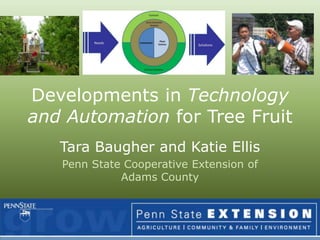Developments in Technology and Automation for Tree Fruit
- 1. Developments in Technology and Automation for Tree FruitTara Baugher and Katie EllisPenn State Cooperative Extension of Adams County
- 2. Penn State Specialty Crop Innovations
- 3. Ag Innovations TeamPSU FREC – Jim Schupp, Larry Hull, Henry Ngugi, Jim Travis, Greg Krawczyk, Lynn Kime, Edwin Winzeler, Tom KonPSU Southeast Region - Tara Baugher, Katie Ellis, Jim Remcheck, Student InternsPSU State College – Rob Crassweller, Rich Marini, Paul Heinemann, Jay Harper
- 4. Comprehensive Automation for Specialty CropsUSDA-SCRISpecialty Crops Research InitiativeCMU, PSU, Purdue, OSU, WSU, USDA
- 5. Adoption of New Ag Technologies8 yr lag to early adoption/15 yrs to full adoption From Alston, Norton, and PardeyScience Under Scarcity,1995.
- 7. Work EfficiencyAutomated Fruit Transport and Bin FillingHand picking accounts for ~50% of total fruit production costs
- 8. Work Platforms with Harvest CapabilitiesPhoto by Sally Colby
- 9. Monitoring Insect PopulationsGoals:Automatically monitor orchard pest (moth) populations with high spatial and temporal resolutionReduce costs associated with checking conventional traps
- 10. Detection of Plant Stress, Disease, and Insect InfestationsDetection ResultsInput Images
- 11. Autonomous Crop Load ScoutingGoals:Better crop load measurements (more accurate and less costly than manual approach)Crop load measurements influence various orchard management decisions (e.g., matching harvesting to orders; fertilizer, irrigation, pest control measures)Autonomous scouting enables orchard management decisions to be made in a more timely and accurate manner
- 12. Video Imaging of Peachesin cooperation with USDA AFRS/Purdue
- 13. Reconfigurable MobilityGoal: develop reconfigurable vehicles that can be used for several functions, like spraying, mowing, harvest, pruning, and thinning - Research on accurate vehicle positioning to georeferencecrop and environmental conditions
- 15. Seth & Dan BoyerKen Guise/Dave CoxMichael FlinchbaughTony & Terry FettersBrad & Bruce HollabaughBrian JacquesDave & Shawn GarretsonBill GardenhourCorey McCleafNeil StarnerBrian, Kevin, & Kyle KnouseEd & Justin WeaverUnited States Department of AgricultureNatural Resources Conservation Services Conservation Innovation Grant
- 16. Field Laboratories on New Training Systemsfor Intensive Orchards Narrow Vertical AxisVertical Axis Hedgerow(4-Wire Trellis)
- 17. Peach SystemsPerpendicular VBird’s Eye ViewHex VQuad VConventional Open CenterBird’s Eye View
- 18. Engaging StakeholdersTechnology AdoptionSocioeconomic surveysValue propositionOutreachFeedback fromadvisory panel
- 19. Penn State Cooperative Extension of Adams CountyPenn State Fruit Research and Extension CenterPenn State Departments of Agricultural and Biological Engineering and Horticulturewww.cascrop.comPenn State College of Agricultural Sciences research, extension, and resident education programs are funded in part by Pennsylvania counties, the Commonwealth of Pennsylvania, and the U.S. Department of Agriculture.Where trade names appear, no discrimination is intended, and no endorsements by Penn State Cooperative Extension is implied.The Pennsylvania State University is committed to the policy that all persons shall have equal access to programs, facilities, admission, and employment without regard to personal characteristics not related to ability, performance, or qualifications as determined by University policy or by state or federal authorities. It is the policy of the University to maintain an academic and work environment free of discrimination, including harassment. The Pennsylvania State University prohibits discrimination and harassment against any person because of age, ancestry, color, disability or handicap, national origin, race, religious creed, sex, sexual orientation, gender identity, or veteran status. Discrimination or harassment against faculty, staff, or students will not be tolerated at The Pennsylvania State University. Direct all inquiries regarding the nondiscrimination policy to the Affirmative Action Director, The Pennsylvania State University, 328 Boucke Building, University Park, PA 16802-5901; Tel 814-865-4700/V, 814-863-1150/TTY.
Editor's Notes
- #3: grassroots initiative to retool orchards with innovative technologies
- #4: Penn State team that began working together in 2005
- #5: Positioned us for a very comprehensive SCRI, with CMU as the leadEmphasis on apples, but with focus on technologies of use to all specialty cropsMain themes in project
- #6: şÝşÝߣ that represents the adoption process in agriculture Lag time – reason for a such a comprehensive approach
- #8: Hope to have a short term success increasing harvest efficiencyFruit transport and bin filler systems
- #10: Another project that is promising
- #11: Initial focus on early detection of diseases such as fire blight; but this shows you the research on detecting leafroller damage on fruit
- #12: Commercialization partner Vision RoboticsReport monthly at our team meetings – progress pretty remarkable
- #14: CMU’s role
- #15: Example of one function
- #18: In peaches, looking at 3 systems compared to OC
- #19: The early engagement of stakeholders was what led to initial funding, and the importance is on-goingWhen you have ideas, please share them. Versatile project team focused on challenges presented by growers



















